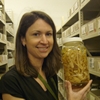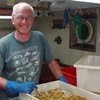General Description
Rostrum with 7-10 dorsal teeth, usually 8, 2-3 posterior to orbit of the eye; 4-6 ventral teeth, usually 5. Branchiostegal spine falling short of carapace margin. Branchiostegal groove not running back along the carapace from hepatic spine. Fifth segment (carpus) of second leg (pereopod 2) longer than fourth segment (merus); fixed finger with cutting edge bearing 2 proximal teeth; 1 tooth between these on last segment (dactylus). Anteroventral corner of carapace square or slightly rounded. Distinct oblique and transverse red lines on carapace; few scattered red, olive and black chromatophores forming indistinct transverse lines on abdominal somites; antennule inner flagellum with definite red and white bars, persisting as purple bars in ethanol-preserved specimens. Up to 4 cm long.
Biology
This species is one of the most common shallow water shrimp found in southern Australia. It is most commonly found on muddy soft sediments especially in the shelter of seagrasses. When alive the shrimp is translucent, marked with fine purple-red lines running along the carapace and more sparsely on the abdomen. This species has been commonly referred to as Macrobrachium intermedium in the ecological literature but has since been placed in the genus Palaemon.
Habitat
Seagrass and algae, 0-22 m depth.
Soft substrates
Seagrass meadows
Reefs
Coastal shores
Distribution guide
Indo-west Pacific Oceans, including southern Australia.
Species Group
Prawns, shrimps, lobsters › Shrimps
Depth
Shore (0-1 m)
Shallow (1-30 m)
Water Column
Max Size
4 cm
Diet
Organic matter
Commercial Species
No
Global Dispersal
Recorded in Australia
Species Code
MoV 1001
Conservation Status
- DSE Advisory List : Not listed
- EPBC Act 1999 : Not listed
- IUCN Red List : Not listed






